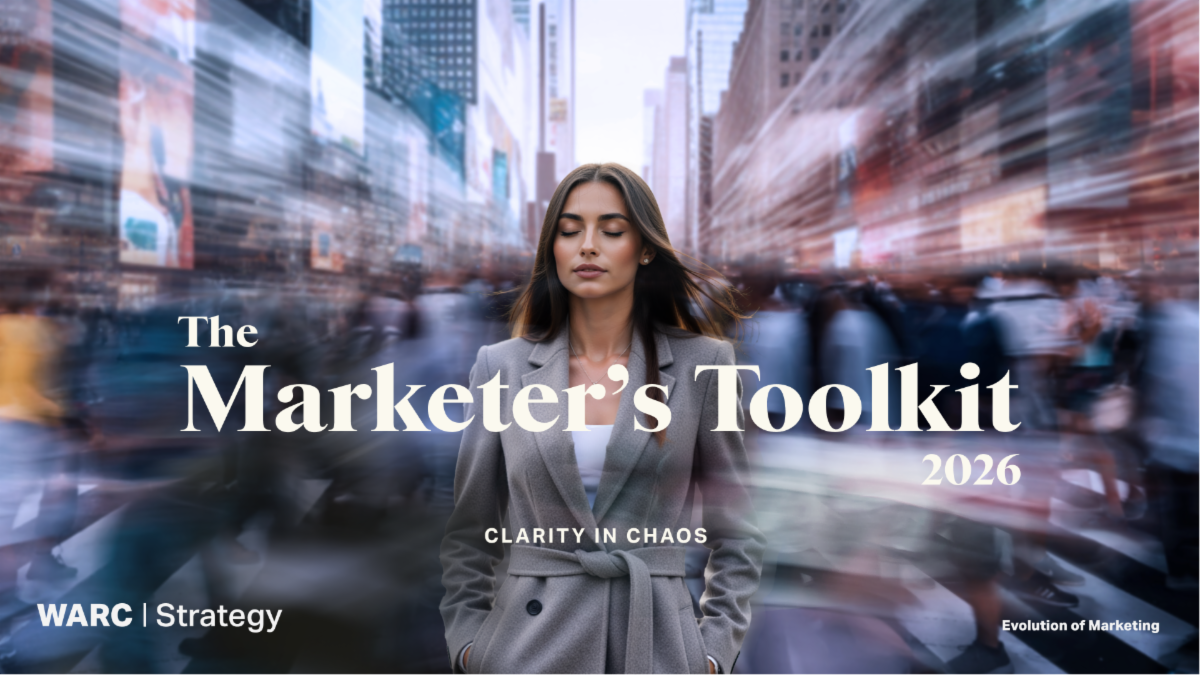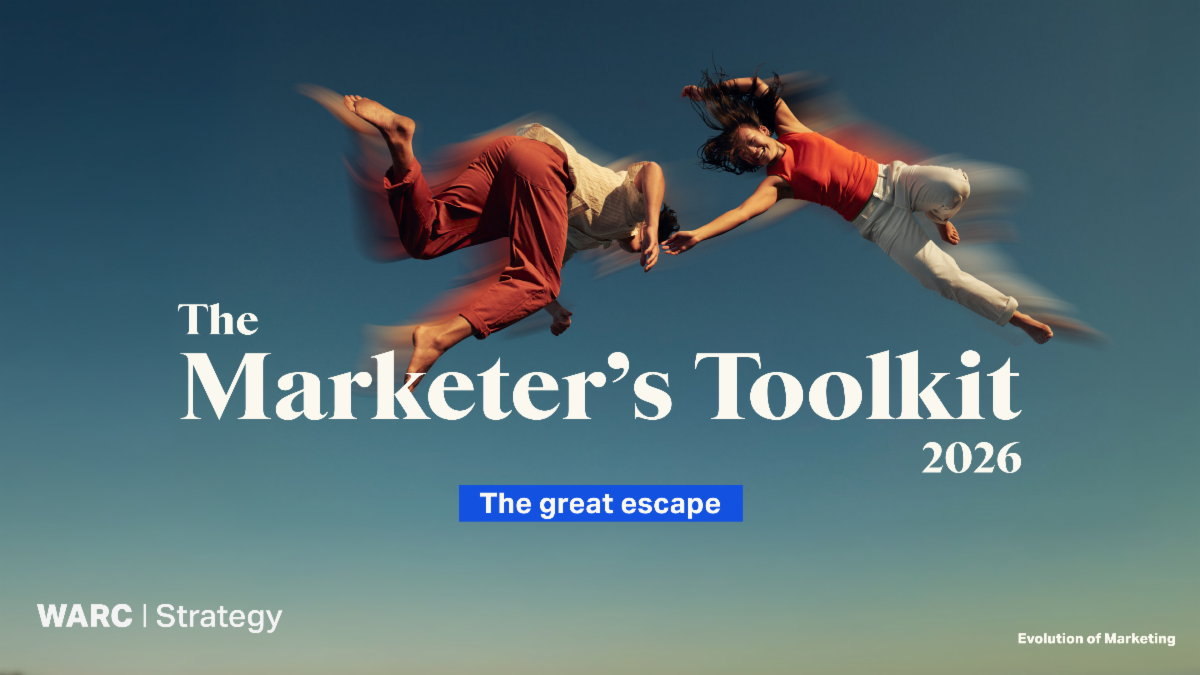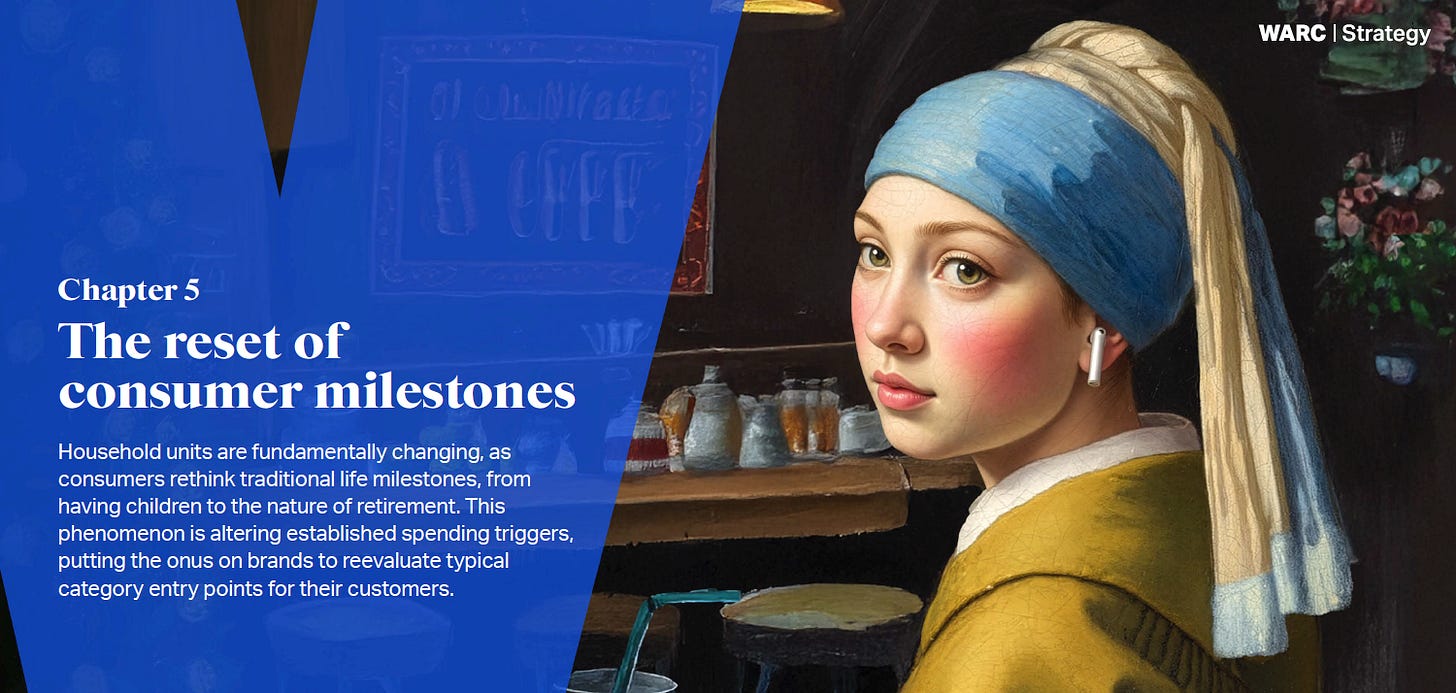The Marketer's Toolkit 2026: Navigating Uncertainty as Consumer Priorities Shift
WARC Unveils Five Critical Trends Reshaping Marketing Strategy Amidst 11-Point Drop in Marketer Confidence
As economic instability continues to reshape consumer behaviour and spending patterns, WARC has released its highly anticipated Marketer’s Toolkit 2026, revealing five critical trends set to disrupt global marketing practices and reshape brand strategies in the year ahead. Now in its 15th year, this flagship report from WARC’s Evolution of Marketing programme provides marketers with strategic insights for planning and decision-making in an increasingly uncertain environment.
Based on WARC’s proprietary GEISTE methodology which analyses macro-level drivers across government, economy, industry, society, technology, and environment the report incorporates findings from a global survey of more than 1,000 marketing executives, alongside one-to-one interviews with leading marketers worldwide and analysis from WARC’s global team of experts.
The research reveals a stark reality: marketer confidence has dropped 11 points from last year, with only 54% of marketers surveyed in 2024 expecting things to be better next year, down from 65%. Yet this cautious outlook exists alongside a WARC Media forecast of 8.1% global advertising spend growth, reaching $1.27 trillion in 2026.
“Going into 2026, the only certainty is that there will be uncertainty. Unpredictable tariffs, geopolitical threats, and economic instability are impacting consumer spending, lifestyles and ambitions. Our survey found marketer optimism is down 11 points from last year, with 54% of marketers saying they expect things to be better next year, versus 65% surveyed in 2024. But understanding consumer shifts and how to adapt quickly to cater to them could create new opportunities for brands in 2026.”
Aditya Kishore, Insight Director at WARC
Going into 2026, the only certainty is that there will be uncertainty. Tariffs are only one part of an unpredictable US policy agenda, whilst geopolitical threats and climate change dangers continue to build. The IMF sees risks tilted towards the downside for 2026, with global growth slowing to 3.1%, and advanced economies growing just 1.5%.
The Vanishing Middle
The first and perhaps most consequential trend identified in the Toolkit concerns the erosion of the middle market traditionally the bedrock of category growth offering brands both scale and margin. The report reveals that 73% of marketers agree that the term “middle-class” is becoming meaningless, with wide variances seen across wealth, income, and attitudes towards spending.
This phenomenon represents a quiet dissolution that has reached a tipping point. The concentration of wealth amongst the top 10% of Americans, who now drive 50% of US spending, demonstrates a scale of inequality that is unprecedented. And notably, it’s not just hurting lower-income households: middle-income households have been steadily losing their role as the “centre of economic gravity.”
This shift has now become a global issue, affecting a range of European and Asian nations. Even the mighty Chinese middle class is struggling, facing a property crisis, slowing economic growth, and the maturing of previous growth drivers including global expansion and urbanisation.
The trend has macro-level implications. A strong, prosperous middle class has been seen as the bedrock of healthy economies and societies by both economists and policymakers. It also poses a huge challenge for marketers, who have traditionally built categories on the back of the middle market before expanding into premium and budget segments.
The impact on businesses is becoming increasingly evident. As median incomes have remained sluggish, the costs of a middle-class lifestyle—including house prices, the cost of education, and childcare—have surged. At the same time, job security has plunged, with one-in-six middle-income jobs facing high risk of automation. More than 20% of US middle-income households now spend more than they earn, leading to debt, financial insecurity, and sharply reduced spending.
The middle class is effectively bifurcating, with the better-off moving up the spend spectrum, whilst others anxiously cut costs. Recent private credit sector failures are raising new concerns about the ongoing availability of funding for both businesses and consumers, and their ability to repay.
Younger Consumers Accelerate Middle Market Decline
This division of the middle market will widen amongst younger generations. The children of wealthy baby boomers are set to inherit $84 trillion in coming years, the largest wealth transfer in history. Meanwhile, the majority of less fortunate younger millennials and Generation Z are battling a negative wealth problem as growing debt stifles their life chances.
There are signs that this is creating a crisis of ambition. Interest in a university education, a critical determinant of lifetime income, is declining. So is interest in rising up the corporate ladder. This will further limit financial opportunities.
For some, the response is a focus on living in the moment, cutting costs in some areas so they can trade up in categories that really matter to them. Brands will need to better understand consumer spend patterns and trade-offs for their individual categories to find the pockets of opportunity. Insight into consumers’ state of mind as well as emotional and values-based decision drivers will be critical.
Finding a New Place on the Price Spectrum
Apart from simply cutting prices, two broad approaches have emerged for brands: “premiumise” by repositioning the brand as more upscale, or reframe value to strengthen their price-value equation for more budget-conscious consumers.
As the report points out, the automobile industry is now trying to sell fewer, more expensive cars, rather than catering to a declining middle class. It’s not the only sector; this premiumising of brands and portfolios is a sustained trend across categories including house paints, airlines, and beauty care.
Obviously, brand strategy and investment will become more important than ever, as the success of this approach will be heavily dependent on shifting brand perception.
The Boomer Opportunity
Higher-income households are now powering the global economy, and older cohorts now hold much of the world’s wealth: $15 trillion in purchasing power by 2030, whilst making up 35% of international travellers. They are also more adventurous than previous generations at the same age. This will create new opportunities for brands that can cater to their requirements.
Reframing Value for Customers
Consumers with less spending power are also splitting their spend, but it’s driven by increased intentionality as they spend more on some items whilst cutting down on others.
The “living in the moment” mindset of younger consumers appears to favour travel and experiences. Saving for homes and splurging on big weddings are in decline, whilst mindfulness and mental health matter more. Understanding these shifts will help brands tap into younger cohorts’ priorities.
Successful marketers will be able to understand and address the tension between what consumers still want to do but are struggling to afford. Offering small premium options for those on a budget could be one strategy. A good example of this approach is the premium white label options from supermarkets. Another strategy is “barbell” pricing, which some restaurant chains have used effectively, offering low-priced menu options for the budget-constrained customer but also including higher-end items for those looking for a more upscale dining experience.
Tapping into cultural nuances can be effective when done with a clear understanding of customer variances, whilst purpose or other emotionally-driven value propositions could help sway customers regardless of price. High-quality customer service as well as practical benefits and rewards for loyal customers can also help with customer loyalty—increasingly important as the market drifts away from the middle. Total cost of ownership (TCO), a concept widely used in B2B purchasing, can be useful here, helping brands evidence long-term savings resulting from long-lasting, high-quality products.
In Their Own Words
“I think that people can really tell the difference when things are crafted beautifully. We are a premium brand. We cost a bit more. And especially in the world we’re heading into, I think craft can become a really powerful differentiator for brands.”
Brent Smart, CMO of Telstra
“Chili’s has always been a place for everyone. Our ‘barbell’ pricing strategy offers everyday value and premium options, keeping the brand relevant across the spend spectrum. Showcasing this approach in our marketing has kept this balance visible to our guests, helping Chili’s grow even in a challenging economic environment.”
George Felix, SVP & CMO of Chili’s Grill & Bar
Case Study: Nailed with OPPO
Award: Curious Felis, Silver, 2024 Agency: Happy People Project, Istanbul Advertiser: OPPO Market: Turkey
Smartphone manufacturer OPPO needed to stand out in the crowded Turkish middle market. It recognised that middle-market customers in Turkey were sensitive to the financial burden of repairing or replacing damaged phones.
Rather than lower its price, the brand identified an opportunity to build a strategy around its A60 model’s military-grade durability. The campaign used real-life demonstrations to highlight its toughness, including using the phone to hammer nails. Recognising the similarity of the Turkish words for “nailed” and “shot,” it developed the tagline “Nailed It With A60” as a clever play on iPhone’s “Shot on iPhone.”
Results:
The campaign drove sale volumes that exceeded projections by 75%
The three films generated approximately 500,000 organic social media views on the first day and over 7 million views in total
Takeaways:
Promoting the A60 phone’s durability helped consumers appreciate the TCO or long-term economy of the product, differentiating it in a crowded middle market
OPPO proved that empathising with the middle market squeeze doesn’t always mean price cutting. Instead, value enhancement or adapting the value proposition can be more effective
Key Takeaways for The Vanishing Middle
Help your customers navigate affordability tension - Brands will need to address gaps between what consumers still want and what they can still afford. There will be opportunities for narrowly sliced premium tiers in certain categories. Using a portfolio strategy catering to varying price points within the same category will help match costs with willingness to pay.
Build emotional connections with your brand - Strong brands are proven to have lower price elasticity. As the middle market loses momentum, brand investment will be required more than ever. Being able to build emotional connections with consumers will help sustain demand even in challenging categories. Deep understanding of cultural nuances, ideological values, and belief systems will be critical here.
Identify cohort-oriented strategies to drive growth - Affluent boomers are a particularly valuable segment. Adapting value propositions to serve their specific requirements could be beneficial. At the other end of the age spectrum, understanding increased intentionality and what drives younger audiences’ purchase priorities will be the key to finding the right pockets of opportunity within those cohorts.
Chapter 2: The Creator Gamble
Brands perceive influencers and creators to be vital in helping them achieve their goals, but face challenges in being effective with their creator marketing investments. The tension between reach and control is likely to come to a head in 2026.
The second trend examines what has become one of marketing’s most pressing dilemmas. Whilst 61% of marketers plan to increase their investment in influencer and creator marketing in 2026, creator return on investment suffers from high levels of volatility.
The creator economy has experienced explosive growth, with investment flowing into partnerships, sponsored content, and influencer collaborations across platforms. Yet demonstrating tangible effectiveness remains elusive for many brands. The challenges include measuring true impact on sales, ensuring brand safety and alignment, managing authenticity as partnerships become more commercial, and navigating the volatility of creator audiences and engagement rates.
This gamble represents a significant risk for marketing budgets. Brands see creators as essential for achieving their goals—particularly in reaching younger audiences and building authentic connections. But the inability to demonstrate clear ROI creates tension between the desire for reach and the need for accountability.
Chapter 3: The Great Escape
In a world weighed down by polycrisis, consumers are seeking an escape. Brands can help consumers move away from doomscrolling by investing in emotionally immersive experiences that transport people out of the everyday and restore connection.
Chapter three of the Toolkit identifies a profound shift in consumer behaviour driven by what the report terms “polycrisis”—the convergence of multiple, interconnected global challenges. From economic uncertainty and geopolitical tensions to climate change and social fragmentation, consumers face a relentless stream of concerning news and challenging realities.
The response has been a growing desire for escapism—not in the form of denial, but through experiences that provide genuine respite, joy, and human connection. The data supports this trend: for enhanced experiences, most marketers are pursuing both digital channels (78%) and in-person events (74%).
This dual approach recognises that consumers are moving away from passive doomscrolling towards active engagement with pastimes, events, and immersive experiences. Whether through festivals, immersive theatre, themed retail experiences, or carefully curated travel, brands have an opportunity to create moments that transport people out of their everyday stresses.
The great escape is about offering emotional value that goes beyond functional product benefits. It’s about creating spaces—physical or digital—where consumers can disconnect from their concerns and reconnect with joy, wonder, and human connection. Brands that can deliver these experiences authentically will build deeper emotional bonds with their customers.
Chapter 4: The Zero-Click Customer Journey
Artificial intelligence is gaining influence across the customer journey, from search to generative engine optimisation and agentic commerce. Marketers will need to scale up their experiments with AI whilst, in most cases, continuing to invest in more established strategies and channels.
Perhaps no trend carries more immediate tactical implications than the rise of AI across every stage of the customer journey. Yet the Toolkit reveals a surprising gap between concern and action: only 11% of marketers are “not particularly worried” about the impact of AI on search. Most are working on AI search strategies, with 24% shifting from search engine optimisation (SEO) to generative engine optimisation (GEO).
The “zero-click” future—where AI-powered search engines, chatbots, and shopping agents provide answers, recommendations, and even complete transactions without consumers needing to visit brand websites—represents a fundamental transformation of digital marketing.
As large language models become embedded in search engines, shopping platforms, and consumer devices, the traditional path to purchase is being disrupted. Consumers can now ask AI assistants for product recommendations, price comparisons, and purchasing decisions, with the AI potentially completing the transaction without the consumer ever “clicking through” to a brand’s digital presence.
This shift creates both challenges and opportunities. On one hand, brands risk losing direct relationships with customers and valuable first-party data. On the other, those who successfully optimise for AI-mediated discovery could reach consumers at precisely the moment of intent with highly relevant information.
The report counsels measured experimentation whilst maintaining investment in established strategies and channels. This balanced approach recognises that whilst AI capabilities are expanding rapidly, proven marketing fundamentals—brand building, customer relationships, and multi-channel presence—retain their importance. The winners will be those who can integrate AI strategies whilst strengthening their core marketing effectiveness.
Chapter 5: The Reset of Consumer Milestones
Household units are fundamentally changing, as consumers rethink traditional life milestones, from having children to the nature of retirement. This phenomenon is altering established spending triggers, putting the onus on brands to reevaluate typical category entry points for their customers.
The fifth trend addresses a quieter but equally profound shift in consumer behaviour. The Toolkit reveals that 53% of marketers believe segmentation schemes based on age, income, social class, and family structures are not really effective anymore.
Traditional life milestones—marriage, children, home ownership, university graduation—have historically served as key triggers for category entry and increased spending across multiple sectors. A couple getting married typically purchases new furniture, kitchenware, and potentially a home. Having children drives spending on everything from larger vehicles to life insurance. These predictable patterns have underpinned marketing strategies and product development for decades.
But these milestones are being delayed, reimagined, or forgone entirely by younger generations. Marriage rates are declining, with many couples choosing long-term partnerships without formal marriage. Home ownership is increasingly out of reach for young adults in many markets, with rising prices and stagnant wages creating barriers to entry. Birth rates are falling across developed economies as couples delay or decide against having children. Even university education, once considered essential for economic mobility, is being questioned as costs soar and alternative paths to career success emerge.
This reset of consumer milestones fundamentally alters when and why consumers make major purchase decisions. A 30-year-old today may have entirely different spending priorities than a 30-year-old did 20 years ago. Traditional age-based marketing assumptions no longer hold.
For brands, this means reevaluating typical category entry points and developing new frameworks for understanding purchase triggers. Rather than relying on demographic proxies like age or family status, marketers need deeper insights into individual values, priorities, and life circumstances.
The phenomenon will accelerate as intergenerational wealth transfer reshapes spending patterns. Those who inherit significant wealth may suddenly have purchasing power that doesn’t align with their age or career stage. Meanwhile, those without family wealth face extended financial constraints that delay traditional milestone purchases indefinitely.
Interest in rising up the corporate ladder is also declining, suggesting a broader rethinking of ambition and success. For some consumers, the response is a focus on “living in the moment”—prioritising experiences, travel, and personal development over accumulating material goods or achieving traditional markers of success.
Brands must adapt by understanding what truly motivates purchase decisions in this new landscape. This requires moving beyond demographic segmentation towards psychographic and behavioural understanding. What values drive this consumer? What experiences do they prioritise? What problems are they trying to solve? These questions become more important than simply knowing their age or family status.
A Robust Methodology for Uncertain Times
The Marketer’s Toolkit is based on WARC’s proprietary GEISTE framework, which focuses on six macro-level drivers of change: Government, Economy, Industry, Society, Technology, and Environment.
Once this research identifies the disruptive forces shaping the coming year, WARC analysts assess their impact on marketers via a multi-stage process, and then select the trends that have the greatest impact. Subsequent research and analysis, including interviews with marketing leaders worldwide and a global survey, help define and validate the most effective strategies to manage these changes and identify new areas of opportunity.
The process includes:
Extract - Analyse and extract critical themes from research
Evaluate - Evaluate macro-trend impacts on marketers
Select - Global expert inputs to analyse and select trends
Validate - Validate trends via large-scale marketer survey, in-depth CMO interviews, and internal WARC data analysis
Synthesise - Synthesise multiple forms of data and insight, conduct final reviews, and produce report
Unless specified otherwise, all survey data in this report is from the 2025 Voice of the Marketer survey, an online survey of 1,000+ marketers worldwide, conducted from September to October 2025.
Conclusion: From Chaos to Clarity
As marketers navigate 2026, the Toolkit offers both analytical framework and practical guidance. The five trends—the vanishing middle, the creator gamble, the great escape, the zero-click customer journey, and the reset of consumer milestones—represent fundamental shifts in how consumers think, behave, and spend.
The report emphasises that granular understanding of consumer trade-offs will be critical to reframe value, alongside brand investment that delivers stronger pricing power through enhanced brand equity. Deep insight into consumers’ emotional and values-based decision drivers becomes essential as traditional segmentation loses effectiveness.
It’s true marketer optimism is down 11 points from last year, and nearly twice as many respondents to the survey expected marketing budgets to decline. But WARC Media still forecasts global ad spend growth of 8.1% to $1.27 trillion in 2026, and 54% of marketers expect business to be better next year.
That’s more than half who remain positive, expecting to find clarity and direction amidst all the uncertainty. As Kishore concludes, whilst marketers face an environment where “the only certainty is that there will be uncertainty,” understanding these five transformative trends provides the clarity needed to turn chaos into strategic opportunity.
These changes could create new opportunities for brands that can understand them and adapt quickly to cater to them. For the marketers who can find clarity in chaos, 2026 offers genuine potential for growth.
The Marketer’s Toolkit 2026 is available to WARC subscribers as part of the Evolution of Marketing programme, the leading source of insight into the changing face of marketing. For information on how to subscribe, visit warc.com/contact-us.
Related reports from the Evolution of Marketing programme include: The GEISTE report (analysis of major macro-level forces shaping 2026), The Voice of the Marketer (granular analysis from survey of 1,000+ marketers), and Future of Media (major developments in media and technology).











